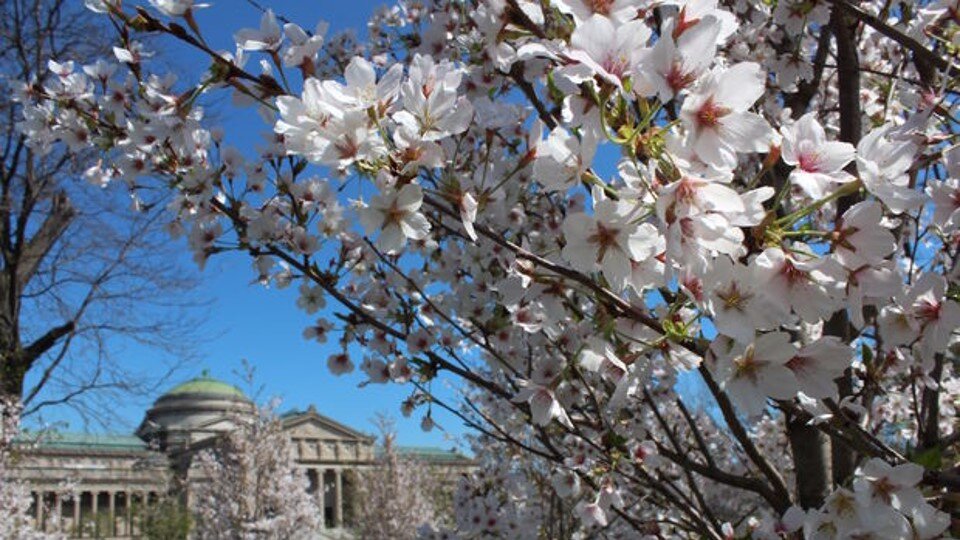April 22, 2013 | One Man’s Dream: A Revitalized Jackson Park (Crain’s Chicago)
2017 | Cherry trees described in the article, and planted in 2013. (Photo courtesy of Dayne Kono)
ARTICLE: One Man’s Dream: A Revitalized Jackson Park (Crain’s Chicago)
Phoenix rising once again? A local lawyer is hoping to restore the Japanese gardens in Jackson Park to their former glory, one cherry tree at a time
Written by Steven R. Strahler | Read Article in CRAIN'S CHICAGO
When Robert Karr Jr. closes his eyes, he sees cherry blossoms. Thousands of cherry blossoms on hundreds of trees, like the ones that are a springtime ritual in Washington. He sees them in a revitalized Jackson Park, Frederick Law Olmsted's tarnished South Side jewel.
Mr. Karr, a lawyer and executive vice president of the Japan America Society of Chicago, also sees Chicagoans enjoying concerts in a Ravinia-style music pavilion and gazing upon the park's lagoon as they make use of a new, park-facing entrance to the Museum of Science and Industry.
How much of this will come to fruition depends in large part on Mr. Karr's fundraising prowess and on how many others share his vision for this underused public space.
“When you go down there, it's less than inspiring,” he says. “It has the potential to be one of the most innovative urban parks in the nation, where science, nature and humanity can be experienced and explored.”
The Chicago Park District is taking the lead in planting 135 trees over the next few weeks, but most follow-on efforts south of the Museum of Science and Industry will depend on Mr. Karr, 43, and millions of private-sector dollars.
“We start small and we see how it goes. It's going to build on itself,” says Adam Schwerner, the park district's director of natural resources.
HISTORIC BEGINNINGS
The idea is to burnish a Japanese motif dating to the 1893 World's Columbian Exposition, when Japan built the Phoenix Pavilion, spending more than any other foreign nation at the world's fair to symbolize its emergence from centuries of diplomatic isolation. The Ho-o-den—the Japanese name of the pavilion—caught the eye of Frank Lloyd Wright, then working as an Adler & Sullivan architect on the exhibition's Transportation Building, and influenced his “destruction of the box” Prairie style of architecture.
The Phoenix Pavilion on Olmsted's 15-acre Wooded Island operated until the attack on Pearl Harbor and succumbed to a fire shortly after the war. A Japanese garden was revived and renamed Osaka Garden in 1993 to commemorate the 20th anniversary of Chicago's sister-city relationship. Upkeep of the two-acre site on the north end of the island is supported by the Garden of the Phoenix Foundation, where Mr. Karr is a board member.
The city made a run at sprucing up the area beginning in the late 1970s. But Japan's economic dominance—Japan Inc., in the shorthand of the day—discouraged local interest in subsidizing Japanese themes, according to Mr. Karr, a principal at Chicago law firm Masuda Funai Eifert & Mitchell Ltd.
Even today, it could be a slog to raise the $10 million or more he says is needed to include a 10,000- to 15,000-square-foot music pavilion near the museum's southeast corner, site of a music court during the Columbian Exhibition. Tour buses now idle there.
While the park district's involvement is crucial, with $2 billion in deferred maintenance citywide it won't be much of a financial backstop. It already has funded new and restored beach houses, underpasses and other Jackson Park capital projects, says Erma Tranter, president of Friends of the Parks watchdog group.
Mr. Karr, who took Japanese in high school on a girlfriend's dare and developed a legal clientele that includes Tokyo's Sumitomo Corp., is establishing a nonprofit called Project 120 Chicago to lure individual, foundation and corporate donors. He's counting more on a slow buildup and $10 crowdsourced donations than on a big windfall.
BLOSSOMING
Ultimately, there could be more than 250 cherry trees around the Columbia Basin—the pond area between the museum and Wooded Island—and on the island itself, where 18 were planted last year. Each tree planting costs about $500, Mr. Schwerner says. The Japanese Chamber of Commerce and Industry of Chicago has pledged 50 trees.
Another beautification force is the Jackson Park Advisory Council, led by Louise McCurry, 63, a family nurse practitioner, who ventures that park use has tripled since 2010, after volunteer cleanups and a new nature path and soccer fields made the area feel more secure.
“It's the difference between night and day,” she says.
For landscape design work, Mr. Karr enlisted museum architect Kulapat Yantrasast, 44, a native Thai with five commissions from the Art Institute of Chicago. Among them are the Jaharis Galleries of Greek, Roman and Byzantine Art and the Japanese Gallery incorporating wood panels from the Phoenix Pavilion.
On Mr. Karr and Mr. Yantrasast's wish list—and Mr. Schwerner's, too—is re-establishing the Museum of Science and Industry's original orientation by reopening south doors, now emergence exits, that had been the main entrance to the Columbian Exhibition's Palace of Fine Arts. A museum spokeswoman declines to comment on the prospect.
“Olmsted truly wanted the water and uniting the grand buildings with water-oriented accesses to be the main impression,” the Los Angeles-based Mr. Yantrasast says. “This will definitely restore that meaning.”
Mr. Yantrasast's involvement closes another circle. He apprenticed in Japan under Tadao Ando, who chose to be an architect after he was dazzled by Tokyo's Imperial Hotel. Its architect: Frank Lloyd Wright.
-END


